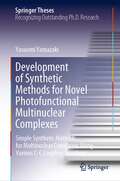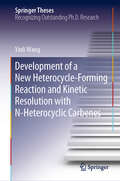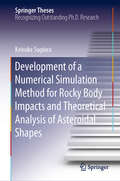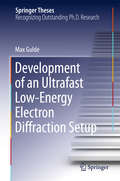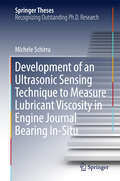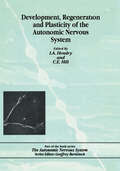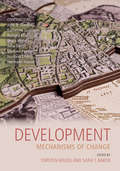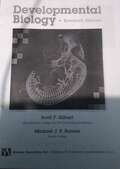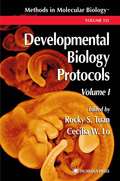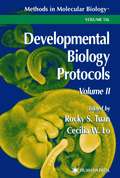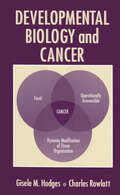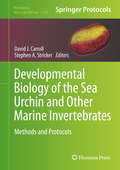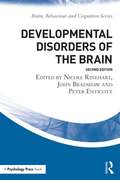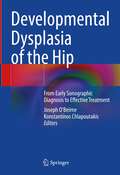- Table View
- List View
Development of Synthetic Methods for Novel Photofunctional Multinuclear Complexes: Simple Synthetic Methods for Multinuclear Complexes Using Various C-C Coupling Reactions (Springer Theses)
by Yasuomi YamazakiThis book presents several helpful synthetic methods for diverse multinuclear complexes. The results described can be used to selectively connect mononuclear as well as multinuclear complexes with other metal complexes to construct valuable photofunctional compounds. Using the new synthetic methods, it was possible to selectively connect several types of metal complexes in a single step under relatively mild reaction conditions. This so-called building block approach utilizes various C–C coupling reactions between metal complexes with functional groups as active moieties. Owing to the large pi-conjugation systems, the multinuclear complexes synthesized using coupling reactions showed a strong absorption ability over a wide range of visible light and long emission lifetimes, which are ideal properties for photosensitizers and light absorbers. By combining these coupling methods with the newly developed hydrogenation reactions, the binding mode of the linkers in multinuclear complexes can be modified in order to tune the photophysical properties and photocatalytic ability. As such, the synthesized multinuclear complexes can be used for various purposes, e.g., as photocatalysts and photosensitizers, and in light-harvesting systems. The synthetic methods and strategies presented in this book diversify not only the structures but also functions of multinuclear complexes.
Development of The Ocular Lens
by Frank J. Lovicu Michael L. RobinsonThis book provides a comprehensive view of research in lens developmental biology, emphasising technical and molecular breakthroughs. Elucidation of the mechanisms that govern lens development has enabled us to understand how the normal lens forms and how developmental processes are involved in the maintenance of its normal structure, function and growth throughout life. This knowledge is fundamental to our understanding of many lens disorders. The ocular lens has also become a model for understanding the developmental biology of more complex organ systems. In this 2004 book, leading experts in lens cell biology and development discuss lens evolution, induction, morphology, the regulation of the lens cell cycle and fiber cell differentiation, as well as lens regeneration. This book is an authoritative treatment of the subject that will serve as a reference for graduate students and research scientists in developmental biology and in the visual sciences, as well as for ophthalmologists.
Development of a New Heterocycle-Forming Reaction and Kinetic Resolution with N-Heterocyclic Carbenes (Springer Theses)
by Yinli WangIn this book, the author focuses on exploring new organocatalytic transformations under operationally simple and environmentally friendly reaction conditions. Two new types of catalytic reactions promoted by N-heterocyclic carbenes (NHCs) are described. The oxa- and azacycle-forming reactions of sulfonylalkynols and sulfonylalkynamides are broadly considered to be a new type of activation mode in NHC chemistry, wherein the bond formation with internal O- and N-nucleophiles occurs at the γ-position of the propargyl sulfones with 1,2-sulfonyl migration. The resulting oxa- and azacycles are core structures in many biologically significant compounds and medicinally important agents. In addition, the book develops the chiral NHC-catalyzed kinetic resolution of α-hydroxy carboxylic acid derivatives based on chiral recognition of the substrate–cocatalyst complex. In this carboxylate cocatalyst-assisted chiral acylation, the reaction rate acceleration and selectivity enhancement are interpreted in terms of the reversible complexation of the substrate and carboxylate cocatalyst, which is verified by control experiments and measured using analytical methods. The findings described here reveal a promising new aspect of not only NHC catalysis but also identifying novel catalysis systems.
Development of a Numerical Simulation Method for Rocky Body Impacts and Theoretical Analysis of Asteroidal Shapes (Springer Theses)
by Keisuke SugiuraThis book describes numerical simulations of collisions between asteroids, based on a unique numerical code developed by the author. The code accurately solves the elastic dynamic equations and describes the effects of fracture and friction, which makes it possible to investigate the shapes of impact outcomes produced by asteroid collisions and subsequent gravitational accumulation of fragments.The author parallelizes the code with high parallelization efficiency; accordingly, it can be used to conduct high-resolution simulations with the aid of supercomputers and clarify the shapes of small remnants produced through the catastrophic destruction of asteroids. The author demonstrates that flat asteroids can only be produced by impacts involving objects with similar mass and low velocity, which suggests that the flat asteroids in our solar system were created in the planet formation era and have kept their shapes until today. The author also shows that asteroid collisions under certain conditions can produce the extremely elongated shape of an interstellar minor body, 1I/‘Oumuamua. In brief, the book offers a comprehensive investigation of asteroid impacts and shapes, making it a uniquely valuable resource.
Development of a Sub-glacial Radio Telescope for the Detection of GZK Neutrinos
by Thomas MeuresThe goal of the project presented in this book is to detect neutrinos created by resonant interactions of ultrahigh energy cosmic rays on the CMB photon field filling the Universe. In this pioneering first analysis, the author puts forward much of the analysis framework, including calibrations of the electronic hardware and antenna geometry, as well as the development of algorithms for event reconstruction and data reduction. While only two of the 37 stations planned for the Askaryan Radio Array were used in this assessment of 10 months of data, the analysis was able to exclude neutrino fluxes above 10 PeV with a limit not far from the best current limit set by the IceCube detector, a result which establishes the radio detection technique as the path forward to achieving the massive volumes needed to detect these ultrahigh energy neutrinos.
Development of an Efficient Modelling Approach to Support Economically and Socially Acceptable Flood Risk Reduction in Coastal Cities: Can Tho City, Mekong Delta, Vietnam (IHE Delft PhD Thesis Series)
by Hieu Quang NgoFlooding is one of the most frequently occurring and damaging natural disasters worldwide. Quantitative flood risk management (FRM) in the modern context demands statistically robust approaches (e.g. probabilistic) due to the need to deal with complex uncertainties. However, probabilistic estimates often involve ensemble 2D model runs resulting in large computational costs.Additionally, modern FRM necessitates the involvement of a broad range of stakeholders via co-design sessions. This makes it necessary for the flood models, at least at a simplified level, to be understood by and accessible to non-specialists. This study was undertaken to develop a flood modelling system that can provide rapid and sufficiently accurate estimates of flood risk within a methodology that is accessible to a wider range of stakeholders for a coastal city – Can Tho city, Mekong Delta, Vietnam. A web-based hydraulic tool, Inform, was developed based on a simplified 1D model for the entire Mekong Delta, flood hazard and damage maps, and estimated flood damages for the urban centre of Can Tho city (Ninh Kieu district), containing the must-have features of a co-design tool (e.g. inbuilt input library, flexible options, easy to use, quick results, user-friendly interface). Inform provides rapid flood risk assessments with quantitative information (e.g. flood levels, flood hazard and damage maps, estimated damages) required for co-designing efforts aimed at flood risk reduction for Ninh Kieu district in the future.
Development of an Ultrafast Low-Energy Electron Diffraction Setup
by Max GuldeThis book presents an Ultrafast Low-Energy Electron Diffraction (ULEED) system that reveals ultrafast structural changes on the atomic scale. The achievable temporal resolution in the low-energy regime is improved by several orders of magnitude and has enabled the melting of a highly-sensitive, molecularly thin layer of a polymer crystal to be resolved for the first time. This new experimental approach permits time-resolved structural investigations of systems that were previously partially or totally inaccessible, including surfaces, interfaces and atomically thin films. It will be of fundamental importance for understanding the properties of nanomaterials so as to tailor their properties.
Development of an Ultrasonic Sensing Technique to Measure Lubricant Viscosity in Engine Journal Bearing In-Situ
by Michele SchirruThis thesis presents a novel ultrasonic instrument for non-invasive and in-situ characterization of journal bearing lubricant viscosity. In particular, the application to journal bearings is described by non-invasively measuring the viscosity and localized power losses throughout operation. This ultrasonic viscometer is based on the reflection of polarized shear waves from a thin resonating coating layer to increase the measurement sensitivity, in comparison to conventional ultrasonic methods. This instrument allows for a full engine oil viscoelastic characterization in-situ. The book investigates the effects of temperature, pressure and shear rate, and describes in detail the ultrasonic setup and method. Further, it demonstrates that the same technique can be applied similarly to monitor the lubrication of other engine components. As such, it offers a unique instrument that can drive the research of oil formulations to improve engine performance and fulfill the requirements of international fuel economy regulations.
Development, Inclusion and Sustainability: Issues and Perspectives (Sustainable Development Goals Series)
by Amrita Datta Abhinav Alakshendra Bhim ReddyThis book addresses the overarching theme of promoting inclusive and sustainable development through twelve contributions that discuss perspectives from emerging economies and policies for a better world. The contributions are divided into four sections -- Employment and Livelihoods; Capabilities and Mobilities; Sustainable and Inclusive Urbanization; and Perspectives for Policies. The first section contains two chapters that deal with employment and labour markets. In the second section, there are four contributions that discuss capabilities (education and health) and their roles in intergenerational mobility, contributing to poverty reduction and inclusive development. The third section comprises of four chapters concerning various aspects of urbanisation in diverse empirical contexts. And the last section consists of two contributions providing policy perspectives. The volume is thus a diverse mix of empirical research and provides critical insights into the Global South’s development process. It is an important reference for all those concerned with sustainable and inclusive development.
Development, Regeneration and Plasticity of the Autonomic Nervous System
by I. A. Hendry C. E. HillEach volume in the Autonomic Nervous System series deals with a different area of autonomic control in health and disease. This, the second volume, provides an overview on the nature of the factors that exert constraints on the differentiation and maturation of the autonomic nervous system. Subjects covered include: development of autonomic neurones; molecules affecting nerve growth and survival; regeneration after injury; and the degree to which the wiring of the nervous system is rigid or fixed.
Development: Mechanisms of Change (Darwin College Lectures #29)
by Torsten Krude Sara T. BakerThis volume collects essays from prominent intellectuals and public figures based on talks given at the 2015 Darwin College Lectures on the theme of 'development'. The writers are world-renowned experts in such diverse fields as architecture, astronomy, biology, climate science, economy, psychology, sports and technology. Development includes contributions from developmental biologist and Nobel laureate John B. Gurdon, Olympic gold medallist Katherine Grainger, astronomer and cosmologist Richard Ellis, developmental psychologist Bruce Hood, former Met Office Chief Scientist Julia Slingo, architect Michael Pawlyn, development economist Ha-Joon Chang and serial entrepreneur Hermann Hauser. While their perspectives and interpretations of development vary widely, their essays are linked by a common desire to describe and understand how things change, usually in the direction of ever-increasing complexity. Written with the lay reader in mind, this interdisciplinary book is a must-read for anybody interested in the mechanisms underlying the changes we see in the world around us.
Developmental Approaches to Human Evolution
by Julie Boughner Campbell RolianDevelopmental Approaches to Human Evolution encapsulates the current state of evolutionary developmental anthropology. This emerging scientific field applies tools and approaches from modern developmental biology to understand the role of genetic and developmental processes in driving morphological and cognitive evolution in humans, non-human primates and in the laboratory organisms used to model these changes. Featuring contributions from well-established pioneers and emerging leaders, this volume is designed to build research momentum and catalyze future innovation in this burgeoning field. The book's broad research scope encompasses soft and hard tissues of the head and body, including the skeleton, special senses and the brain. Developmental Approaches to Human Evolution is an invaluable resource on the mechanisms of primate and vertebrate evolution for scholars across a wide array of intersecting disciplines, including primatology, paleoanthropology, vertebrate morphology, evolutionary developmental biology and health sciences.
Developmental Behavioral Neuroscience: The Minnesota Symposia on Child Psychology, Volume 24 (Minnesota Symposia on Child Psychology Series #Vol. 24)
by Megan R. Gunnar Charles A. NelsonThis volume provides an introduction to current research on the relation between brain development and the development of cognitive, linguistic, motor, and emotional behavior. At least two audiences will benefit from this book: psychologists interested in brain development, and neuroscientists interested in behavioral development. Although each chapter is content-oriented, the volume as a whole provides a well integrated summary of the latest findings from developmental behavioral neuroscience.
Developmental Biology
by Scott F. Gilbert Michael J. F. BarresiA classic gets a new coauthor and a new approach: Developmental Biology, Eleventh Edition, keeps the excellent writing, accuracy, and enthusiasm of the Gilbert Developmental Biology book, streamlines it, adds innovative electronic supplements, and creates a new textbook for those teaching Developmental Biology to a new generation. Several new modes of teaching are employed in the new Gilbert and Barresi textbook. The videos explaining development--as well as those from Mary Tyler's Vade Mecum--are referenced throughout the book, and several other valuable new elements have been added.
Developmental Biology Protocols, Volume I
by Rocky S. Tuan Cecilia W. LoDrawing on state-of-the-art cellular and molecular techniques as well as new and sophisticated imaging and information technologies, this comprehensive, three-volume collection of cutting-edge protocols provides readily reproducible methods for studying and analyzing the events of embryonic development. Volume 1 (ISBN: 089603-574-3) contains techniques for establishing and characterizing several widely used experimental model systems, for the study of developmental patterns and morphogenesis, and for the examination of embryo structure and function. There are also step-by-step methods for the analaysis of cell lineage, the production and use of chimeras, and the experimental and molecular manipulation of embryos, including the application of viral vectors. Volume 2 (ISBN: 0-89603-575-1) describes state-of-the-art methods for the study of organogenesis, the analysis of abnormal development and teratology, the screening and mapping of novel genes and mutations, and the application of transgenesis, including the production of transgenic animals and gene knockouts. No less innovative, volume 3 (ISBN: 0-89603-576-X) introduces powerful techniques for the manipulation of developmental gene expression and function, the analysis of gene expression, the characterization of tissue morphogenesis and development, the in vitro study of differentiation and development, and the genetic analysis of developmental models of diseases. Highly practical and richly annotated, the three volumes of Developmental Biology Protocols describe multiple experimental systems and details techniques adopted from the broadest array of biomedical disciplines.
Developmental Biology Protocols, Volume II
by Rocky S. Tuan Cecilia W. LoDrawing on state-of-the-art cellular and molecular techniques as well as new and sophisticated imaging and information technologies, this comprehensive, three-volume collection of cutting-edge protocols provides readily reproducible methods for studying and analyzing the events of embryonic development. Volume 1 (ISBN: 089603-574-3) contains techniques for establishing and characterizing several widely used experimental model systems, for the study of developmental patterns and morphogenesis, and for the examination of embryo structure and function. There are also step-by-step methods for the analaysis of cell lineage, the production and use of chimeras, and the experimental and molecular manipulation of embryos, including the application of viral vectors. Volume 2 (ISBN: 0-89603-575-1) describes state-of-the-art methods for the study of organogenesis, the analysis of abnormal development and teratology, the screening and mapping of novel genes and mutations, and the application of transgenesis, including the production of transgenic animals and gene knockouts. No less innovative, volume 3 (ISBN: 0-89603-576-X) introduces powerful techniques for the manipulation of developmental gene expression and function, the analysis of gene expression, the characterization of tissue morphogenesis and development, the in vitro study of differentiation and development, and the genetic analysis of developmental models of diseases. Highly practical and richly annotated, the three volumes of Developmental Biology Protocols describe multiple experimental systems and details techniques adopted from the broadest array of biomedical disciplines.
Developmental Biology Protocols, Volume III
by Rocky S. Tuan Cecilia W. LoDrawing on state-of-the-art cellular and molecular techniques as well as new and sophisticated imaging and information technologies, this comprehensive, three-volume collection of cutting-edge protocols provides readily reproducible methods for studying and analyzing the events of embryonic development. Volume 1 (ISBN: 089603-574-3) contains techniques for establishing and characterizing several widely used experimental model systems, for the study of developmental patterns and morphogenesis, and for the examination of embryo structure and function. There are also step-by-step methods for the analaysis of cell lineage, the production and use of chimeras, and the experimental and molecular manipulation of embryos, including the application of viral vectors. Volume 2 (ISBN: 0-89603-575-1) describes state-of-the-art methods for the study of organogenesis, the analysis of abnormal development and teratology, the screening and mapping of novel genes and mutations, and the application of transgenesis, including the production of transgenic animals and gene knockouts. No less innovative, volume 3 (ISBN: 0-89603-576-X) introduces powerful techniques for the manipulation of developmental gene expression and function, the analysis of gene expression, the characterization of tissue morphogenesis and development, the in vitro study of differentiation and development, and the genetic analysis of developmental models of diseases. Highly practical and richly annotated, the three volumes of Developmental Biology Protocols describe multiple experimental systems and details techniques adopted from the broadest array of biomedical disciplines.
Developmental Biology and Cancer
by Gisele M. Hodges Charles RowlattThis book addresses possible analogies between cancer and developmental biology. An international group of experts provides a multidisciplinary approach, allowing biological or clinical scientists involved with cancer research to integrate specific information from diverse areas.Five concepts of cancer are presented, and developmental biology is reviewed at five levels. These are integrated in discussions of failure in organisation as a basis of cancer and its control. The book will be a valuable reference for both newcomers as well as experienced biological and clinical scientists.
Developmental Biology in Prokaryotes and Lower Eukaryotes
by Tomás González Villa Trinidad de Miguel Bouzas‘Developmental biology’ is widely understood as processes, which mainly concern embryonic animal development and differentiation of cells and tissue. It is also often defined as the timeline for the evolutionary developmental biology of eukaryotic multicellular higher organisms, i.e., plants and animals. The development of prokaryotes and lower eukaryotes in contrary has been neglected for a long time, which was the motivation for publishing this book. This book highlights one of Darwin's most important findings: Evolution is a creative, but not a conscious process. It also illustrates that this concept does not only apply to multicellular higher organisms, but affects every form of life.The reader shall find complex biochemical and genetic pathways of bacteria, yeasts or protozoa, comparable to those exhibited by plants or animals. The molecular mechanisms of dramatic genome rearrangements, recombination and horizontal gene transfer that are responsible for evolutionary adaptations are discussed. Additionally, the book covers bacteria of the genera Myxobacteriales and Caulobacterales, which are able to develop tissue-like cellular organization. The morphogenesis of entomopathogenic fungi and the endosymbiont theory are also addressed. The book is a useful introduction to the field for junior scientists, interested in bacteriology, protistology and fungal development. It is also an interesting read for advanced scientists, giving them a broader view of the field beyond their area of specialization.
Developmental Biology of Peripheral Lymphoid Organs
by Peter BaloghThe human immune system is a complex network of tissues and organs dispersed throughout the body. Immunology, as one of the most rapidly evolving fields in bio¬medical research, has to date covered the essential cellular and molecular events neces¬sary for immune responses to occur. However, it has paid relatively little attention to important developmental processes underlying the formation of the tissues themselves that carry out immune responses in humans and other mammalians. In contrast to the thymus and bone marrow that are the sole tissues for generating mature leukocytes for antigen recognition and han¬dling in humans and most mammalian species, the peripheral lymphoid tissues where adaptive immune responses are focused display broad tissue distribution and possess diverse archi¬tectural characteristics. These organs develop prior to the individual's exposure to external antigens, and despite their similar functions, their varied appearances indicate a substantial complexity of tissue ontogeny. This volume presents a comprehensive overview of the developmental features of the major peripheral lymphoid organs, thus examining the connection between immunological functionality and structural characteristics utilizing a developmental approach, for an audience ranging from undergraduate students to senior researchers in immunology, histology and clinical medicine.
Developmental Biology of the Sea Urchin and Other Marine Invertebrates
by David J. Carroll Stephen A. StrickerIn Developmental Biology of the Sea Urchin and Other Marine Invertebrates: Methods and Protocols, expert researchers in the field detail many of the methods which are now used to study sea urchins and other marine invertebrates in the laboratory. These include methods and protocols on imaging, other useful experimental tools for cell, developmental biology research, variety of molecular biological methods, and strategies for utilizing the sea urchin genome. Written in the highly successful Methods in Molecular Biology series format, chapters include introductions to their respective topics, lists of the necessary materials and reagents, step-by-step, readily reproducible laboratory protocols, and key tips on troubleshooting and avoiding known pitfalls. Authoritative and practical, Developmental Biology of the Sea Urchin and other Marine Invertebrates: Methods and Protocols seeks to aid scientists in the further study into sea urchins and other marine invertebrates.
Developmental Biology of the Sea Urchin and Other Marine Invertebrates: Methods and Protocols (Methods in Molecular Biology #2219)
by David J. Carroll Stephen A. StrickerThis detailed second edition presents a wide variety of marine invertebrate model systems, from cephalochordata to holothurians, along with novel experimental protocols for taking advantage of their unique properties. The techniques range from culturing the organisms to modifying their DNA. Written for the highly successful Methods in Molecular Biology series, chapters include introductions to their respective topics, lists of the necessary materials and reagents, step-by-step, readily reproducible laboratory protocols, and tips on troubleshooting and avoiding known pitfalls. Authoritative and up-to-date, Developmental Biology of the Sea Urchin and Other Marine Invertebrates: Methods and Protocols, Second Edition is an ideal guide for researchers working with these versatile organisms and for furthering our understanding of fundamental biological questions.
Developmental Disorders of the Brain: Neuropsychological, Neuropsychiatric And Evolutionary Perspectives (Brain, Behaviour and Cognition)
by Nicole J. Rinehart John L. Bradshaw Peter G. EnticottDevelopmental Disorders of the Brain: Brain and Behaviour addresses disabilities that occur or have their roots in the early, developmental phase of life which are of utmost concern to parents, siblings, carers and teachers. This text describes the latest clinical and behavioral findings of disorders which largely or entirely involve the frontostriatal (basal ganglia) system including Tourette's, Obsessive-Compulsive and Attention-Deficit-Hyperactivity disorders, Schizophrenia, Autism, gambling and addiction, depression, and Conduct, Developmental Motor Co-ordination, and language disorders. Examples of disorders involving the frontocerebellar are also described such as Asperger's disorder, Williams, Fragile X, and Cerebellar Cognitive Affective syndromes, and Friedreich Ataxia. This book also discusses the relevant anatomy, physiology and pathology, and some of the major functions mediated by affected or relevant structures, together with accounts of the latest recording, brain imaging and stimulating techniques related to these kinds of disorders. Covering both frontostriatal and frontocerebellar, systems which control and direct normal behavior, and which can fail with often distressing consequences during development, as well as addressing behavioural, clinical, pathophysiological and technical aspects, this text is vital to understanding, diagnosis and management of developmental disorders of the brain. This text will be of great interest to clinicians, researchers, teachers and parents.
Developmental Dysplasia of the Hip: From Early Sonographic Diagnosis to Effective Treatment
by Joseph O’Beirne Konstantinos ChlapoutakisThis book is a reference source containing all the relevant information about Developmental Dysplasia of the Hip (DDH), for people who practice or utilize hip sonography for the early detection and treatment of DDH. It aims at improving the population screening for DDH, thus contributing to the elimination of the disorder and its devastating consequences. What makes this book different from existing literature is the fact that, apart from the (updated) information about the disorder (including development, pathophysiology, etiology, pathogenesis, risk factors etc.) and a short technical guidance, the reader will find all relevant knowledge to organize training and set up screening. This includes analysis of the rationale behind universal sonographic screening, a comparative presentation of the sonographic techniques, teaching course structure / management and setting up a screening service, including audit, quality control of the scans etc. Special chapters about radiological diagnosis, imaging the consequences of non-diagnosis or maltreatment of the disorder, clinical management of DDH cases and shaping the future of hip sonography, are also provided. The book will be of interest to any medical doctor, but in particular to those working in the fields of radiology, pediatrics, orthopedics or general medicine, sonographers performing hip scans, or specialist nurses dealing with DDH.
Developmental Genetics and Plant Evolution (Systematics Association Special Volumes)
by Richard M. Bateman Quentin C. B. Cronk Julie A. HawkinsA benchmark text, Developmental Genetics and Plant Evolution integrates the recent revolution in the molecular-developmental genetics of plants with mainstream evolutionary thought. It reflects the increasing cooperation between strongly genomics-influenced researchers, with their strong grasp of technology, and evolutionary morphogenetists and sys
